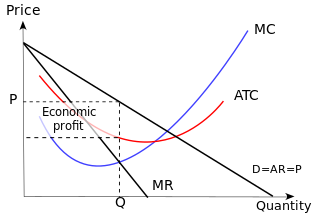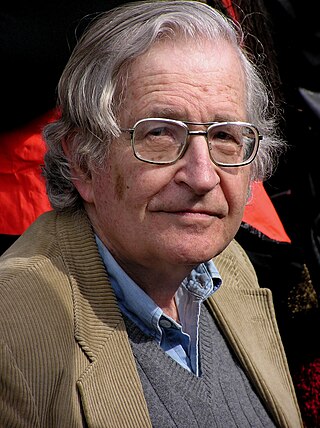Related Research Articles

Monopolistic competition is a type of imperfect competition such that there are many producers competing against each other, but selling products that are differentiated from one another and hence are not perfect substitutes. In monopolistic competition, a company takes the prices charged by its rivals as given and ignores the impact of its own prices on the prices of other companies. If this happens in the presence of a coercive government, monopolistic competition will fall into government-granted monopoly. Unlike perfect competition, the company maintains spare capacity. Models of monopolistic competition are often used to model industries. Textbook examples of industries with market structures similar to monopolistic competition include restaurants, cereals, clothing, shoes, and service industries in large cities. The "founding father" of the theory of monopolistic competition is Edward Hastings Chamberlin, who wrote a pioneering book on the subject, Theory of Monopolistic Competition (1933). Joan Robinson published a book The Economics of Imperfect Competition with a comparable theme of distinguishing perfect from imperfect competition. Further work on monopolistic competition was undertaken by Dixit and Stiglitz who created the Dixit-Stiglitz model which has proved applicable used in the sub fields of international trade theory, macroeconomics and economic geography.

In microeconomics, supply and demand is an economic model of price determination in a market. It postulates that, holding all else equal, in a competitive market, the unit price for a particular good, or other traded item such as labor or liquid financial assets, will vary until it settles at a point where the quantity demanded will equal the quantity supplied, resulting in an economic equilibrium for price and quantity transacted. The concept of supply and demand forms the theoretical basis of modern economics.

In economics, deadweight loss is the difference in production and consumption of any given product or service including government tax. The presence of deadweight loss is most commonly identified when the quantity produced relative to the amount consumed differs in regards to the optimal concentration of surplus. This difference in the amount reflects the quantity that is not being utilized or consumed and thus resulting in a loss. This "deadweight loss" is therefore attributed to both producers and consumers because neither one of them benefits from the surplus of the overall production.

Marketing is the process of identifying customers and "creating, communicating, delivering, and exchanging" goods and services for the satisfaction and retention of those customers. It is one of the primary components of business management and commerce.
In economics, elasticity measures the responsiveness of one economic variable to a change in another. If the price elasticity of the demand of something is -2, a 10% increase in price causes the quantity demanded to fall by 20%. Elasticity in economics provides an understanding of changes in the behavior of the buyers and sellers with price changes. There are two types of elasticity for demand and supply, one is inelastic demand and supply and other one is elastic demand and supply.

A slogan is a memorable motto or phrase used in a clan, political, commercial, religious, and other context as a repetitive expression of an idea or purpose, with the goal of persuading members of the public or a more defined target group. The Oxford Dictionary of English defines a slogan as "a short and striking or memorable phrase used in advertising." A slogan usually has the attributes of being memorable, very concise and appealing to the audience.
In economics, the crosselasticity of demand measures the effect of changes in the price of one good on the quantity demanded of another good. This reflects the fact that the quantity demanded of good is dependent on not only its own price but also the price of other "related" good.
In theories of competition in economics, a barrier to entry, or an economic barrier to entry, is a fixed cost that must be incurred by a new entrant, regardless of production or sales activities, into a market that incumbents do not have or have not had to incur. Because barriers to entry protect incumbent firms and restrict competition in a market, they can contribute to distortionary prices and are therefore most important when discussing antitrust policy. Barriers to entry often cause or aid the existence of monopolies and oligopolies, or give companies market power. Barriers of entry also have an importance in industries. First of all it is important to identify that some exist naturally, such as brand loyalty. Governments can also create barriers to entry to meet consumer protection laws, protecting the public. In other cases it can also be due to inherent scarcity of public resources needed to enter a market.

The propaganda model is a conceptual model in political economy advanced by Edward S. Herman and Noam Chomsky to explain how propaganda and systemic biases function in corporate mass media. The model seeks to explain how populations are manipulated and how consent for economic, social, and political policies, both foreign and domestic, is "manufactured" in the public mind due to this propaganda. The theory posits that the way in which corporate media is structured creates an inherent conflict of interest and therefore acts as propaganda for anti-democratic elements.

A demand curve is a graph depicting the inverse demand function, a relationship between the price of a certain commodity and the quantity of that commodity that is demanded at that price. Demand curves can be used either for the price-quantity relationship for an individual consumer, or for all consumers in a particular market.

Non-price competition is a marketing strategy "in which one firm tries to distinguish its product or service from competing products on the basis of attributes like design and workmanship". It often occurs in imperfectly competitive markets because it exists between two or more producers that sell goods and services at the same prices but compete to increase their respective market shares through non-price measures such as marketing schemes and greater quality. It is a form of competition that requires firms to focus on product differentiation instead of pricing strategies among competitors. Such differentiation measures allowing for firms to distinguish themselves, and their products from competitors, may include, offering superb quality of service, extensive distribution, customer focus, or any sustainable competitive advantage other than price. When price controls are not present, the set of competitive equilibria naturally correspond to the state of natural outcomes in Hatfield and Milgrom's two-sided matching with contracts model.
In marketing, promotion refers to any type of marketing communication used to inform target audiences of the relative merits of a product, service, brand or issue, most of the time persuasive in nature. It helps marketers to create a distinctive place in customers' mind, it can be either a cognitive or emotional route. The aim of promotion is to increase brand awareness, create interest, generate sales or create brand loyalty. It is one of the basic elements of the market mix, which includes the four Ps, i.e., product, price, place, and promotion.

An advertising campaign is a series of advertisement messages that share a single idea and theme which make up an integrated marketing communication (IMC). An IMC is a platform in which a group of people can group their ideas, beliefs, and concepts into one large media base. Advertising campaigns utilize diverse media channels over a particular time frame and target identified audiences.
Green brands are those brands that consumers associate with environmental conservation and sustainable business practices.

A business can use a variety of pricing strategies when selling a product or service. To determine the most effective pricing strategy for a company, senior executives need to first identify the company's pricing position, pricing segment, pricing capability and their competitive pricing reaction strategy. Pricing strategies and tactics vary from company to company, and also differ across countries, cultures, industries and over time, with the maturing of industries and markets and changes in wider economic conditions.

Noam Chomsky is an intellectual, political activist, and critic of the foreign policy of the United States and other governments. Noam Chomsky describes himself as an anarcho-syndicalist and libertarian socialist, and is considered to be a key intellectual figure within the left wing of politics of the United States.

Fast fashion is the business model of replicating recent catwalk trends and high-fashion designs, mass-producing them at a low cost, and bringing them to retail quickly while demand is at its highest. The term fast fashion is also used generically to describe the products of this business model. Retailers who employ the fast fashion strategy include Primark, H&M, Shein, and Zara, all of which have become large multinationals by driving high turnover of inexpensive seasonal and trendy clothing that appeals to fashion-conscious consumers.
Marketing ethics is an area of applied ethics which deals with the moral principles behind the operation and regulation of marketing. Some areas of marketing ethics overlap with media and public relations ethics.

Hoarding in economics refers to the concept of purchasing and storing a large amount of product belonging to a particular market, creating scarcity of that product, and ultimately driving the price of that product up. Commonly hoarded products include assets such as money, gold and public securities, as well as vital goods such as fuel and medicine. Consumers are primarily hoarding resources so that they can maintain their current consumption rate in the event of a shortage. Hoarding resources can prevent or slow products or commodities from traveling through the economy. Subsequently, this may cause the product or commodity to become scarce, causing the value of the resource to rise.

Propaganda is a form of persuasion that is often used in media to further some sort of agenda, such as a personal, political, or business agenda, by evoking an emotional or obligable response from the audience. It includes the deliberate sharing of realities, views, and philosophies intended to alter behavior and stimulate people to act.
References
- ↑ Strange, Adario (April 15, 2015). "Why Apple Loves Gold". Mashable. Retrieved September 11, 2015.
- ↑ Trefis Team (September 2, 2015). "Looking At The Significance Of Sirius XM's Latest $2 billion Share Repurchase Program". Forbes. Retrieved September 11, 2015.
- ↑ MacGregor, C. C. (February 2000). "Economic Theory and Physician Behavior in Bariatric Surgery". Obesity Surgery. Springer. 10 (1): 4–6. doi:10.1381/09608920060674012. PMID 10715635. S2CID 5291713.
- ↑ "Real Demand is Not Artificial". www.american-consensus.org. American Consensus. 2008. Archived from the original on 2016-03-03. Retrieved 2016-07-17.
- ↑ "ZQuote". www.zcommunications.org. 2013-03-09. Archived from the original on March 9, 2013. Retrieved 2016-07-17.
- ↑ "Peace Magazine v03n4p33: Chomsky: Our System Depends on Arms Race". peacemagazine.org. Retrieved 2016-07-17.
- ↑ Chomsky, Noam (1990-01-01). On Power and Ideology. Black Rose Books Ltd. p. 106. ISBN 9780921689041 . Retrieved 2016-07-17.
- ↑ Chomsky, Noam (2004-01-01). Language and Politics . AK Press. pp. 614. ISBN 9781902593821 . Retrieved 2016-07-17.
- ↑ Chomsky, Noam (2002-01-01). Pirates and Emperors, Old and New: International Terrorism in the Real World . South End Press. pp. xi. ISBN 9780896086852 . Retrieved 2016-07-17.
- ↑ Chomsky, Noam (1988-01-01). The Culture of Terrorism. Black Rose Books Ltd. p. 26. ISBN 9780921689287 . Retrieved 2016-07-17.
- ↑ Thomas Russell,(2004),"Advertising creates demand for items",Furniture Today,Vol.28 (41), p.23.
- ↑ Reo Song ; Sungha Jang ; Gangshu (George) Cai,(2016),"Does advertising indicate product quality? Evidence from prelaunch and postlaunch advertising in the movie industry", Marketing letters,Vol.27 (4), p.791-804.
- ↑ Christian Fisher,"Advertising's Effects on Demand",azcentral.
- 1 2 Lamont, Owen A. (2012-06-01). "Go Down Fighting: Short Sellers vs. Firms". The Review of Asset Pricing Studies. 2 (1): 1–30. doi: 10.1093/rapstu/ras003 . ISSN 2045-9920.